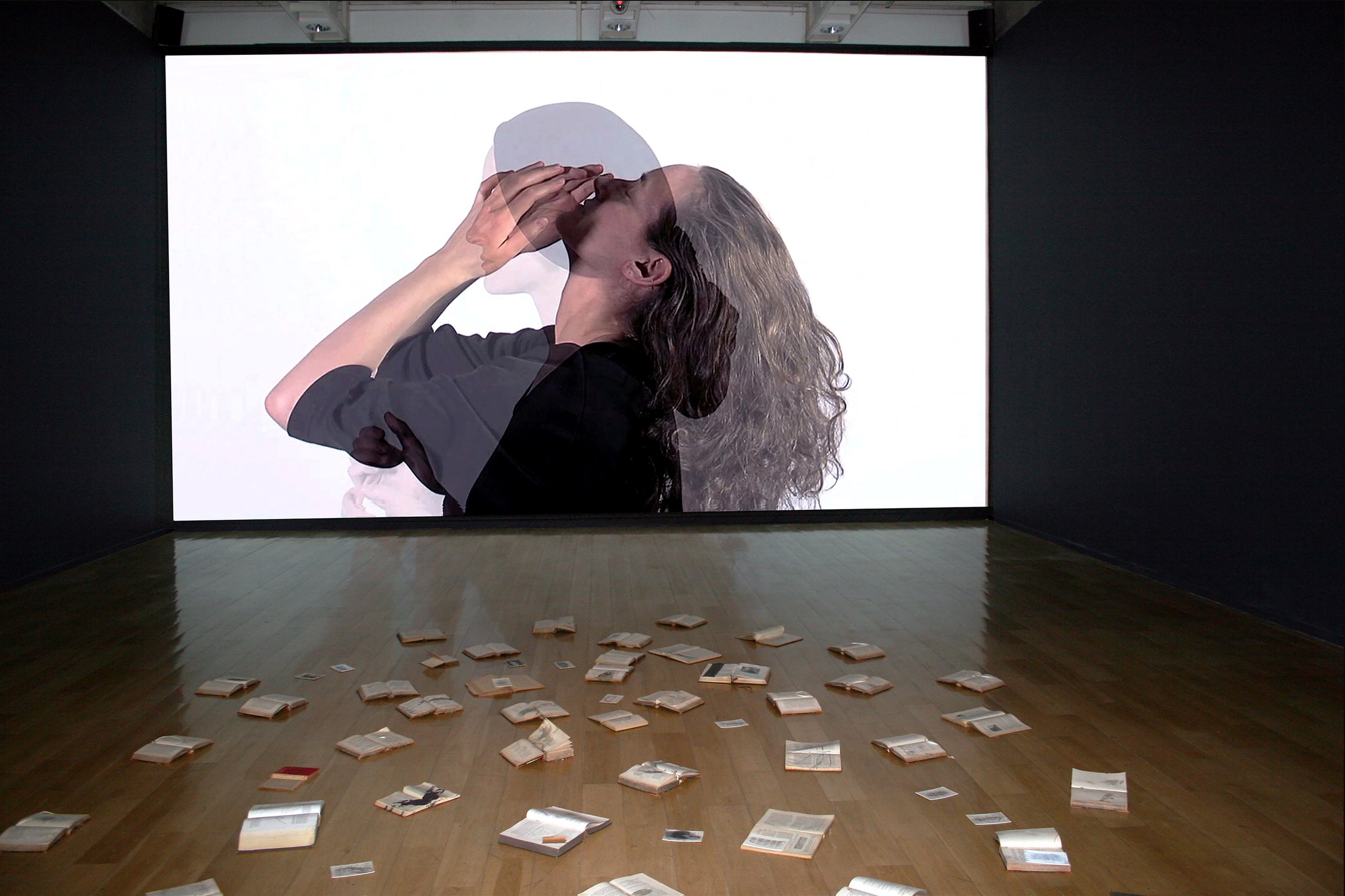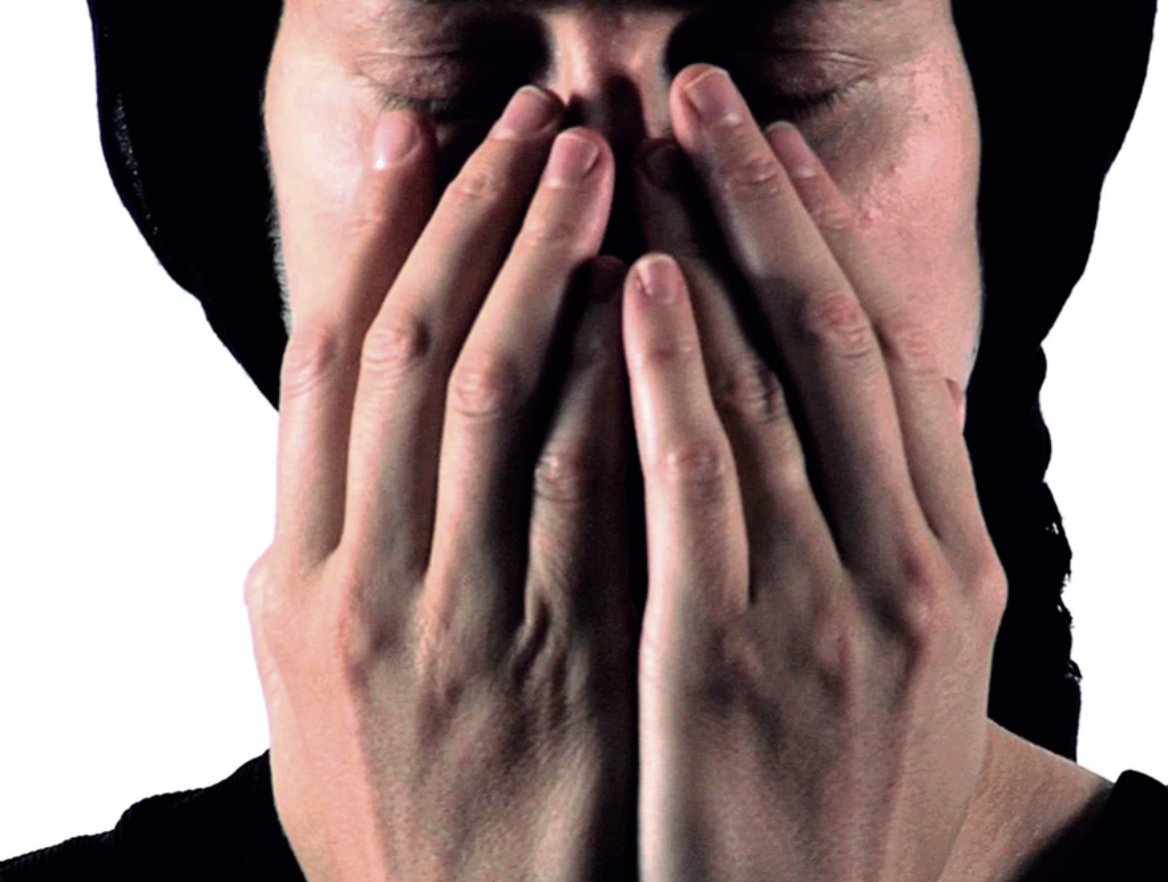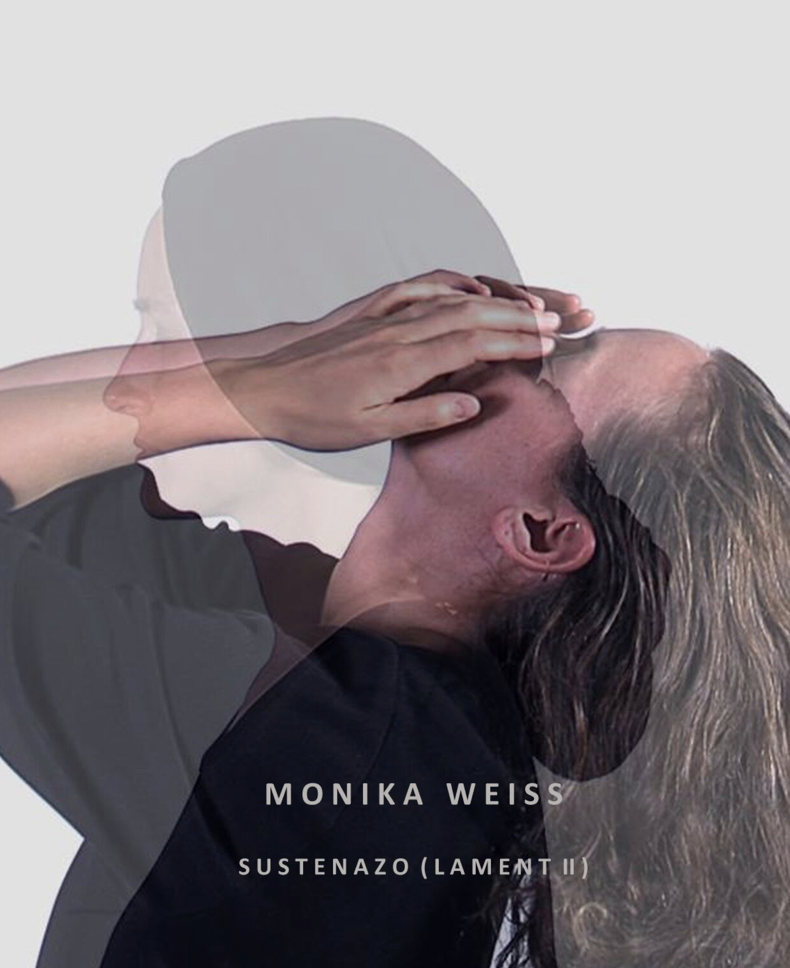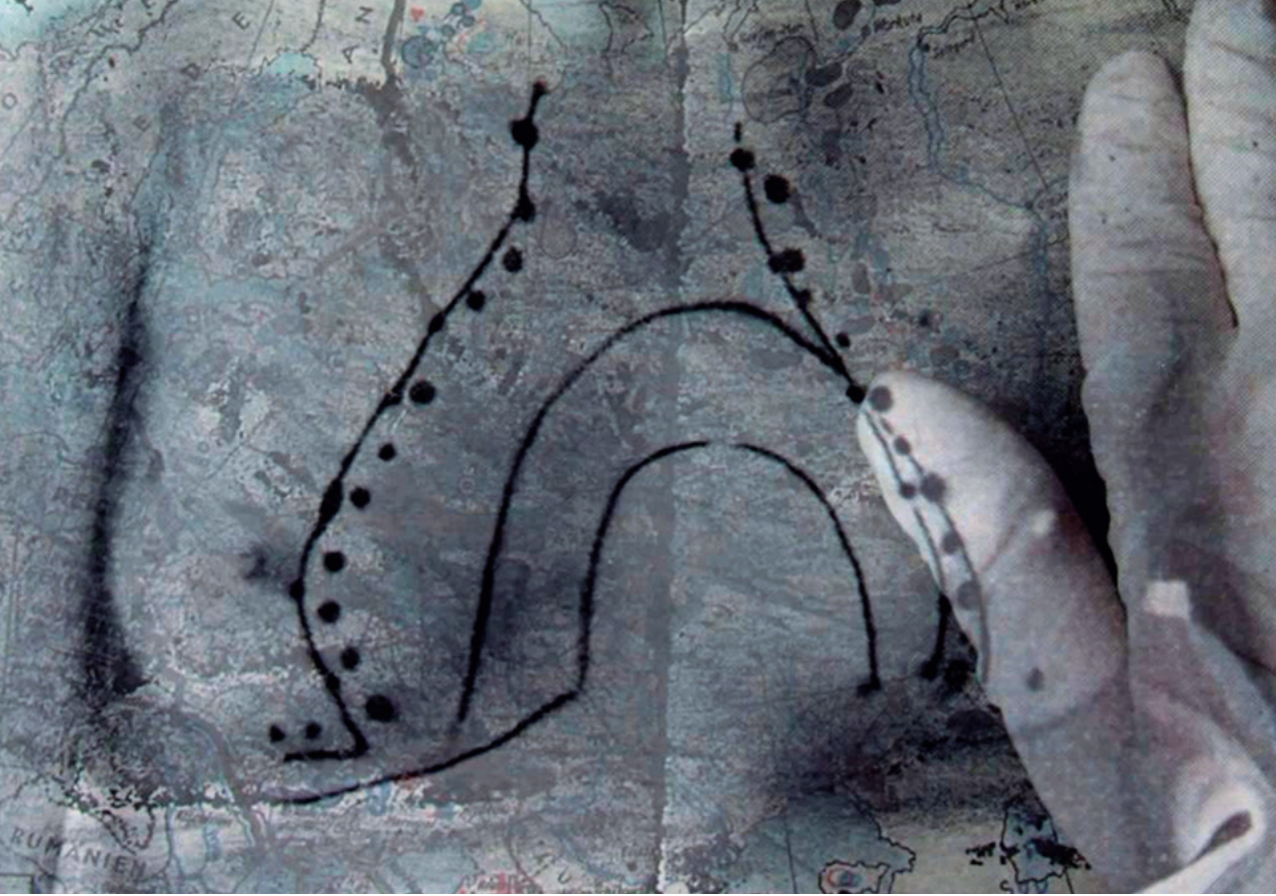adriana valdés
Lamentation and the Locus of Memory: Monika Weiss’s Sustenazo (Lament II)
by Adriana Valdés
Translated from Spanish by N. Davidson
in Monika Weiss: Sustenazo (Lament II), Museum of Memory and Human Rights, Santiago, Chile, 2012
“There is a delicate empiricism which so intimately involves itself with the object that it becomes true theory”
(Goethe) [1]
I
Two time sequences, if not more. They interfere, almost merge, separate, all but merge again. They are and yet are not the same profile, clear-cut and distinct. Two time sequences, if not more, of the same figure, slowly and insistently overlaying itself, with the movements a woman’s body makes as, eyes closed, inwardly, she feels the shock of a deep grief that returns upon itself time and again. Touching her body, tying and untying, covering and uncovering, in a spartan purity of gesture. Two time sequences, if not more, in which the body with its interference of sorrow seeks, eyes closed, for who can say what impossible lucidity, what unattainable comfort. This is what we see.
What we hear is a classically pure, clear voice reading poems by Goethe, but overlaid by the interference of a broken voice that tells the story of a survivor of the events of 1944 in Warsaw. A time sequence, that of poetry, purportedly clear, beyond time or place, receives the shock of a different one which confounds that clarity, contaminates it with another sequence which is more wounded and confused, that of a particular history in a time and place, and which insistently defiles and haunts it.
II
In the second part, it is the music that both establishes and disrupts the time sequence, creates the consonance and the dissonance. Numerous laments (the lament is a musical genre) become a single sound in which sequences and tones are confounded, in which one after another they depart, return, and reappear only to vanish again and again.
We see deft, gloved hands carrying out operations upon a background where images of old medical textbooks – like the ones that materialize in the space in front of the video projection – merge with those of old writings, not easy to decipher, in which Goethe’s name appears; with old maps of a part of Europe; with human torsos photographed long ago, some of them marked up for surgery. The movements of the gloved hands, slow and careful, perform their own operations with old-fashioned instruments that are also physically present in the installation space. They delve but also caress, explore. In the images, once again, time sequences are overlaid and then divide upon one another, returning to coexist as interference.
III
The face again, but from the front now, hands covering it. The eyes, when they can be seen, are firmly shut. If there is a landscape, it is an inward one, in a private mental space, that of mourning. Yet there are many voices reverberating in this inward space, many, overlaying one another, even if they sometimes seem to be saying the same thing. They are texts of Goethe’s once again, read by several German voices and setting up a mutual interference until they become inarticulate, in the way a lament does.
IV
In art, “form” and “content” are indistinguishable: the artistic intelligence fashions and discovers itself through the materials it chooses and the operations it carries out with them. A minute description of the operations in a work is also an exploration of its possible meanings.
Sustenazo (Lament II) arose out of events from a different geography, Warsaw in Poland, and a different time, the closing years of the Second World War. Yet its gestures come home to us and its operations are recognizable. The suffering of our own history, the history shown here in this museum of memory in Santiago, Chile, connects in this work with much older sufferings: we are reminded that the gestures of loss have been with us since the beginnings of our culture. In summoning them, we draw upon a common experience, not constrained by places and dates. We explore this experience— and with it, we may hope, the dimensions of our own grief.
V
The suffering in this work is obstinately feminine, and it is expressed, both to the ear and to the eye, in the forms of the lament. Sustenazo is a Greek word: lamentation, groans, the indistinct sound that comes from a group of mourners, predating articulate speech, situated in that traumatic place where the pain of the body and the pain of the mind come together in a dense convergence. Lamentation is at once expression and silence. It occurs in the presence of a muteness – that of absence, that of death – which resists any kind of articulation or interpretation. What we hear is a genre of music, a timeless lament made up of a number of others that combine to create interference, as the voices also do. What we see is a body closed in upon itself, invaded by outside voices that reverberate and cancel out.
In ancient Athens, the inarticulate excess of women’s grief was treated as a threat to the polis: it must not be allowed to pollute the city. [2] As a form of conduct, says Plato, lamentation is unworthy of a man. [3] Articulate expression in words – in the agora – and martial ardor are what befit males, citizens. (Women, like slaves, were excluded from citizenship in Athens).
VI
From culture to culture, however, the lament refuses to disappear. Since very ancient times, the most diverse spaces have been dedicated to the evocation, the collective summoning up, in some way, of the muteness of absences, the pain of bodies, the rituals of an attachment brutally cut short. Locus memoriae, machina memorialis... [4]
Today’s artists, who dwell so much on extreme bodies [5] rarely think about the body that experiences in the flesh the loss of some other, the breaking of ties, the dispossession of its own being by another’s absence. That is why the approach to lamentation in this machina memorialis constructed by Monika Weiss is not only moving, but surprising too.
Far removed from the political censorship imposed upon it by the Athenians, far removed too from any grief that begins and ends in itself, the lamentation which this work brings to us is an invitation to consider the mourning process in a more contemporary way: as a transformation whose ultimate result is unknowable. [6] This process is experienced by the inner self, with closed eyes; but that “inner self” has historical, cultural and social dimensions. The suffering poetically presented by Monika Weiss shows the lineaments of a history and a political community that are far more complex and demanding than is usually thought,[7] and that are capable of incorporating, rather than segregating, those who have been perennially absent: the victims and the defeated.
Adriana Valdés, Santiago, Chile, 2012
Notes:
[1] This maxim of Johann Wolfgang von Goethe’s is cited in Walter Benjamin, “Little History of Photography,” in Benjamin, Selected Writings, vol. 2: 1927-1934, ed. Michael W. Jennings (Cambridge, Mass.: Belknap Press/Harvard University Press, 1999), p. 520. In the Spanish translation: “Hay una experiencia delicada, identificada tan íntimamente con el objeto que se convierte por ello en teoría.” Walter Benjamin, Discursos interrumpidos I (Madrid: Taurus, 1973), p. 77. I prefer “empiricism” in this case: it is a method of description I aspire to...from afar.
[2] Nicole Loraux, Madres en duelo, trans. Ana Iriarte (Madrid: Abada Editores, 2004), p. 34.
[3] Loraux, Madres en duelo, p. 17 (cited from Plato, Republica, III, 395 E. Arquíloco, fr.13 West) [wouldn’t it be better to cite the Plato in English? – ND].
[4] Mary Carruthers, Machina memorialis, Meditazione, retorica e costruzioni delle immagini (400-1200) (Pisa: Edizione della Normale, 2006) (original English edition, The Craft of Thought [Cambridge: Cambridge University Press, 1998]): “Il luogo - insegna Alberto Magno - aquello che l'anima construisce in se per conservare l'immagine.” p. 18.
[5] See Francesca Alfano Miglietti (FAM), Extreme Bodies: The Use and Abuse of the Body in Art (Milan: Skira, 2003).
[6] “Mourning has to do with agreeing to undergo a transformation the full result of which you cannot know in advance.” Judith Butler, “Beside Oneself: On the Limits of Sexual Autonomy,” in Undoing Gender (New York: Routledge, 2004), p. 18.
[7] “Many think that grief is privatizing, that it returns us to a solitary situation, but I think it exposes the constitutive sociality of the self, a basis for thinking a political community of a complex order.” Butler, “Beside Oneself,” p.[19.
Adriana Valdés
Adriana Valdés was born in Santiago, Chile, in 1943, where she now lives and works. In 1970 she co-founded Taller de Letras, an academic review that is published up to this day. In 1974 she passed the United Nations international examination for translators and joined the Organization’s professional staff in 1975. She took early retirement after a successful 25-year career at the UN Economic Commission for Latin America and the Caribbean. She resumed academic activity at the University of Chile. She started writing about Chilean art in 1977, with a number of other academics and writers – Enrique Lihn, Ronald Kay, Nelly Richard, Cristián Huneeus and others – as a form of resistance, while many Chilean artists and critics had been forced into exile. In 1981 she wrote the first essay ever on Alfredo Jaar, just before he left the country. Some of her essays written between 1976 and 2006 were gathered in the books Composición de Lugar – Ensayos Sobre Cultura (1996) and Memorias Visuales-Arte Contemporáneo en Chile (2006). She is also the author of Enrique Lihn, Vistas Parciales (2008) and De Àngeles y Ninfas – Conjeturas Sobre la Imagen en Warburg y Benjamin (2012). With Alfredo Jaar, she wrote Estudios Sobre la Felicidad (1999). She has edited and published the posthumous work of the poet Enrique Lihn (1929-1988), including both his last book of poetry and his Escritos Sobre Arte, this last one with Ana María Risco. She also edited Alfredo Jaar’s Jaar SCL 2006, the catalogue for his first major exhibition in Chile, the Chilean edition of his La Política de las Imágenes (2008), and Venezia, the book he produced for the 2013 Venice Biennale. She has written several essays on Eugenio Dittborn, in 1979,1985,1992,1997, 1998 and 2005, and on Monika Weiss in 2012.




